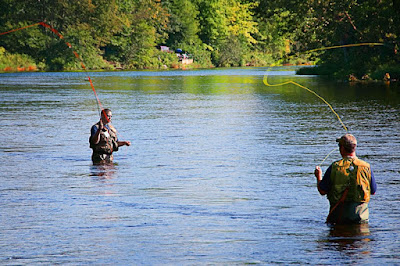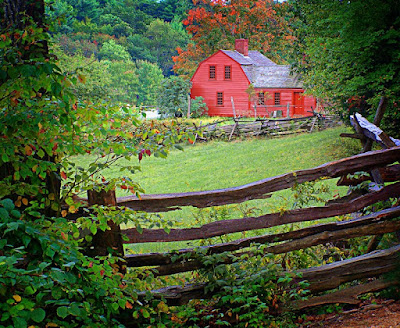 I don't typically come up with fishing when I think of "action" photography. Horse racing, bicycling and badminton tend to come in much higher up on the list. But, for every activity, there has to be some defining moment where you can nod your head and say "that was cool". Even couch potatoes must have their moment. When he/she settles into the couch in just the right position to be able to have a great view of the television and be able to reach both the remote and a beverage with minimum expenditure of energy. Ah, the glory of perfection. Today's image doesn't, itself, approach perfection, but that fellow on the right seems to have a mighty fine arc on the line as he's casting. Okay, he is flyfishing, so his line might be a couple of millimeters in diameter. The most important element in today's image (other than the people themselves) is that thin line slicing through the air. It defines the "peak of action". If either line lay limp, hanging from the tip of the rod to the water, there would be no "action". To get an idea of how the line takes on so much emphasis in this shot, hit the "read more".
I don't typically come up with fishing when I think of "action" photography. Horse racing, bicycling and badminton tend to come in much higher up on the list. But, for every activity, there has to be some defining moment where you can nod your head and say "that was cool". Even couch potatoes must have their moment. When he/she settles into the couch in just the right position to be able to have a great view of the television and be able to reach both the remote and a beverage with minimum expenditure of energy. Ah, the glory of perfection. Today's image doesn't, itself, approach perfection, but that fellow on the right seems to have a mighty fine arc on the line as he's casting. Okay, he is flyfishing, so his line might be a couple of millimeters in diameter. The most important element in today's image (other than the people themselves) is that thin line slicing through the air. It defines the "peak of action". If either line lay limp, hanging from the tip of the rod to the water, there would be no "action". To get an idea of how the line takes on so much emphasis in this shot, hit the "read more".I've done a couple of posts on my basic workflow (link). How I use the saturation portion of Photoshop's Hue/Saturation Adjustment layers to control the intensity of each of the additive and subtractive colors (Red, Green, Blue and Yellow, Cyan , Magenta). Today's image needed an expansion of the basic workflow to include two Red Adjustment Layers, 3 Yellow and 2 Green ALs. Two of the layers are probably pretty obvious. One of the Red ALs is dedicated to the red fishing line and one of the Yellow ALs is the basis of the yellow line. The second Red AL is a "standard" adjustment of the overall image. There are two additional Yellow ALs. The second AL brings the reflection of the trees up in the water. The first pass showed that the amount of saturation that was good for the trees was too much for the water. The water would have looked slightly electric. So, for the Yellow ALs we have the line, the reflection and the trees. Each is a separate Adjustment Layer in order to have the masks for each on. Each mask had to have "holes" punched in them to let the lower adaption show through. The masks end up looking fairly strange.
.
By breaking down an image and addressing each color separately, and possibly with multiple iterations, an almost infinite amount of control can be exercised over the force a color brings to an image. Read more!













.jpg)




